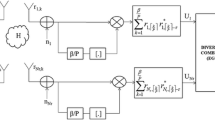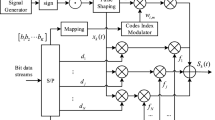Abstract
This paper presents the performance analysis of compound chaotic sequence (CCS)-based noise reduction differential chaos shift keying (NR-DCSK) system under multipath Rayleigh fading channel conditions. The special characteristics of chaotic sequences are their deterministic randomness behaviour that adds security and multipath immunity to the data when used as a carrier in communication systems. In this paper, the chaotic sequences are generated by combining the outputs of chaotic maps, such as logistic map, Chebyshev map, Bernoulli shift map, tent map, etc., leading to new complex sequences known as CCSs. This sequence possesses more randomness, overcomes severe interference levels encountered during transmission and provides higher multipath immunity compared with those of pseudo-noise (PN) codes. Since NR-DCSK is a spread spectrum technique, its performance in wireless multipath fading channels has important considerations. The CCS is used as a carrier in NR-DCSK systems, which leads to improved bit error rate (BER) performance. Comparisons of simulation results to theoretical BER expressions of additive white Gaussian noise (AWGN) and Rayleigh fading channels have been carried out to test the efficiency of the proposed CCS-based NR-DCSK system.








Similar content being viewed by others
References
Tam W M, Lau C M and Tse C K 2006 Digital communication with chaos, 1st ed. Amsterdam: Elsevier
Kolumbán G, Kennedy M P and Kis G 1998 FM-DCSK: a novel method for chaotic communications. In: Proceedings of the International Symposium on Circuits and Systems, Monterey, CA, May 31–June 3, pp. 477–480
Kolumbán G, Kennedy M P, Jákó Z and Kis G 2002 Chaotic communications with correlator receivers: theory and performance limits. Proceedings of the IEEE 90(5): 711–731
Abel A and Schwarz W 2002 Chaos communications—principles, schemes, and system analysis. Proceedings of the IEEE 90(5): 691–710
Galias Z and Maggio G M 2002 Quadrature chaos shift keying: theory and performance analysis. IEEE Transaction of Circuits and Systems I: Fundamentals Theory and Applications 48(12): 1501–1519
Wang L, Zhang C X and Chen G R 2008 Performance of a SIMO FM-DCSK communication system. IEEE Transactions on Circuits and Systems II: Express Briefs 55(5): 457–461
Wang S and Wang X 2010 M-DCSK-based chaotic communications in MIMO multipath channels with no channel state information. IEEE Transactions on Circuits and Systems II: Express Briefs 57(12): 1001–1005
Yang H, Jiang G P 2012 High-efficiency differential-chaos-shift-keying scheme for chaos-based non-coherent communications. IEEE Transactions on Circuits and Systems II: Express Briefs 59(5): 312-316.
Kaddoum G, Soujeri E and Eshteiwi K 2015 I-DCSK: an improved non-coherent communication system architecture. IEEE Transactions on Circuits and Systems II: Express Briefs 62(9): 901–905
Kaddoum G and Nijsure Y 2016 Design of short reference non-coherent chaos-based communication system. IEEE Transactions on Communications 64(2): 680–689
Kaddoum G and Soujeri E 2016 NR-DCSK: a noise reduction differential chaos shift keying systems. IEEE Transactions on Circuits and Systems II: Express Briefs 63(7): 648–652
Lau C M and Tse C K 2003 Chaos-based digital communication systems, 1st ed. Berlin: Springer
Shynk J J 2012 Probability, random variables, and random processes: theory and signal processing applications. New York: Wiley
Proakis J G 2001 Digital communications. New York: McGraw-Hill
Author information
Authors and Affiliations
Corresponding author
Appendix
Appendix
This appendix provides the procedure to obtain simulation results. The BER performance of the CCS-based NR-DCSK system is tested for 100 random initial conditions used for the generation of compound chaotic carrier sequences. Hence, the simulation has one main program that runs the subroutine 100 times. Every time we obtain a BER, it is averaged to obtain the final BER for one particular Eb/No. The second program is the simulation of NR-DCSK system that takes the initial conditions as the input, and returns the BER for one particular value of Eb/No. The third program is again a subroutine used for generating NR structure of the compound chaotic carrier sequences that take the initial conditions and reduction factor \( \frac{\beta }{P} \) from the second program as the inputs and return the NR structure of the chaotic carrier sequences to the second program, which then performs the simulation of the CCS-based NR-DCSK system. The simulation of CCS-based NR-DCSK system comprises the following steps:



Rights and permissions
About this article
Cite this article
Sangeetha, M., Bhaskar, V., Muthamizhchelvan, C. et al. BER performance analysis of compound chaotic sequence (CCS)-based NR-DCSK system under multipath fading channel. Sādhanā 43, 120 (2018). https://doi.org/10.1007/s12046-018-0896-9
Received:
Revised:
Accepted:
Published:
DOI: https://doi.org/10.1007/s12046-018-0896-9




